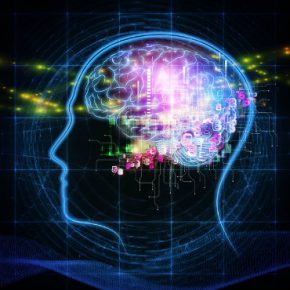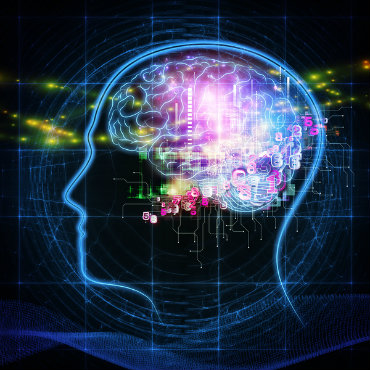
(©Envato)
Artificial Intelligence (AI) is a multi-dimensional concept that encompasses both the imitation of human cognitive functions by machines, as well as their ability to interact with the environment, or the ability to independently achieve goals. Generally speaking, AI is a term applied to the use of computational tools for solving tasks traditionally requiring human intelligence.
Artificial Intelligence has existed for many years as a separate field, but the relatively recent increase in computing power, coupled with increased availability and the amount of generated data, caused a renewed interest in the potential applications of AI, including in the financial sector.
Systems based on AI can exist solely in the form of software functioning in the virtual world (e.g. image analysis software, speech and face recognition systems, voice assistants) or they can be embedded in hardware devices (e.g. autonomous vehicles or Internet of Things, IoT, applications).
Advances in the field of Artificial Intelligence are mainly based on the growing availability and diversity of data, as well as the fact that IT hardware is becoming increasing efficient in terms of mass storage, computing power (in accordance with Moore’s law) and infrastructure (e.g. the emergence of cloud computing). We should also take note of the progress in the field of Deep Learning and the development of tools that enable the utilization of increasingly diverse and large amounts of data (Deep Learning is a specific subfield of Machine Learning whose algorithms are effective in the processing of complex and unstructured data, such as images or voice).
Growing demand for Artificial Intelligence
Artificial Intelligence and Machine Learning already have a number of real-life applications, including in the financial sector (read more). AI is changing the face of this sector, especially by altering the previously existing links between financial institutions. At the same time, it opens up the possibility of using new operating models and introduces new rules of competition, which favour entities primarily focused on the scale and complexity of data, and not necessarily the size of capital.
The utilization of new opportunities related to AI has been the result of supply-side factors, such as technological advancements and the availability of financial sector data and infrastructure, as well as demand-side factors, such as the financial institutions’ needs relating to profitability (e.g. the ability to reduce costs), improved productivity, benefits in managing risk and in competition with other companies.
The demand for these new technologies is also associated with the fact that financial institutions have to comply with growing regulatory requirements. This could be made easier with the use of AI, and entities operating on the financial market are always looking for the most optimal ways of fulfilling the regulatory requirements, such as prudential regulations, data reporting regulations, or provisions on counteracting money laundering and terrorism financing. At the same time, financial supervision institutions have to assess increasingly large and increasingly complex data sets, which means that increasingly effective analytical tools are required to ensure the proper monitoring of the financial sector.
Additional factors strengthening this progress include: consumers’ expectations as they are becoming accustomed to faster and more personalized digital services; increased consumer confidence in technology: and the growing advancement of technological solutions and methodologies, especially in the fields of cybersecurity and modern working methods.
The access to data and the use of data by the financial market institutions, in particular, provide an opportunity to improve so-called customer experience, to increase the efficiency of the distribution functions as well as operational efficiency, and to improve risk management. There is a strong relationship between AI and data: since data is becoming the main feature of competitive advantage for financial institutions, mastering and utilizing AI becomes a strategic priority for these entities.
Personalized products created by Artificial Intelligence
The benefits associated with AI include the ability to offer customers more personalized financial products and services, or to more efficiently process information related to credit decisions, conclusion of contracts, customer relations, etc. The utilization of AI in the lending activities of banks mainly relates to the optimization of the scoring systems on the basis of which loans are granted. Continued improvement of the process of assessing customers’ creditworthiness will be possible thanks to the application of Big Data, also with the use of non-financial data (e.g. data related to consumer behavior on the internet).
One issue that is important in this context, is avoiding discrimination, for example, in credit scoring during the process of granting loans, or when offering insurance products. This is because Artificial Intelligence and Machine Learning algorithms can generate results that are by default correlated with indicators relating to race, religion, gender, for example, on the basis of geographical location or other traits of individuals. The ethical implications of this aspect of Artificial Intelligence are the subject of an ongoing debate.
AI also allows improved risk management, by providing tools for better risk control as well as tools supporting the decision-making processes — both for financial entities and for customers. Meanwhile, from the regulatory perspective, both public and private financial market entities may use new technologies for ensuring compliance with the changing legislation, fulfillment of supervisory obligations, data quality assessment or fraud detection.
New risks
On the other hand, however, Artificial Intelligence and Machine Learning could also generate new risks in the financial system (read more). They may, for example, influence the degree of concentration in the financial markets due to the network effects and the scale of application of new technologies. In the future, this could lead to additional dependency on third parties. This, in turn, could result in the emergence of new systemically important players.
Similarly, access to Big Data may be a source of systemic importance, especially if financial institutions are able to use their proprietary data sources to obtain significant competitive advantages. Additionally, the most innovative technologies may be primarily available to large entities, as the development of the applications of new technologies requires considerable investment outlays (e.g. for the acquisition and maintenance of infrastructure and skilled employees).
As a result of the popularization of AI and Machine Learning, financial services will also be offered on a greater scale by non-bank institutions. Many suppliers and providers of new technologies in the field of financial services may therefore operate outside the existing financial regulations and may not be subject to financial supervision.
There is also certain risk associated with the use of similar algorithms or data streams by various financial market entities. On the one hand, if robo-advisers — aided by machine learning technology — provided advice that is more tailored to the individual needs and preferences of clients, then the investment activities of these customers could be less correlated with the trading strategies of other market participants.
On the other hand, however, the new machine learning-based transaction algorithms may prove to be less predictable than the previously existing rule-based applications and may interact in unexpected ways. The use of Artificial Intelligence and Machine Learning in high-frequency trading, in particular, could be a new source of risk. Especially, if a similar investment strategy based on these technologies is widely used by market participants, this could increase instability on the financial market.
At the same time, there could be increased risk for the financial system as a whole, if it becomes more difficult to interpret or to audit the use of Artificial Intelligence and Machine Learning methods. In the case of many models resulting from their use, full interpretation is difficult or even impossible (especially when it comes to the use of Deep Learning techniques). In addition, many of these models are currently being „trained” during a period of relatively low market volatility. For this reason, these models may not suggest optimal actions in the event of a major economic downturn or the occurrence of a financial crisis, or with regard to adequate risk management in the long term.
The applications of Artificial Intelligence and Machine Learning may also increase the interlinkages of financial markets and financial institutions in unexpected ways. Greater interlinkages in the financial system could support risk sharing and act, at least to a certain extent, as a shock absorber. However, it could also facilitate the propagation of extreme shocks (especially when, for example, a systemically important segment of the financial institutions relies on the same data sources and the same algorithmic strategies).
On top of this, we should also consider the growth in cyber threats, as the use of AI automates repetitive tasks and increases the number of IT connections. This kind of automation could increase the number of vulnerabilities that can be exploited by cybercriminals, for example, through the introduction of false data into the algorithmic models. Moreover, cyberattacks could become more sophisticated and effective thanks to personalized phishing, use of chatbots, or voice-imitation technologies to extract sensitive information.
Artificial Intelligence and Machine Learning are also associated with numerous legal problems related, in particular, to the protection of privacy and data, protection of financial consumers, as well as issues concerning non-discrimination provisions and liability.
New technologies used in the financial market are therefore an important factor forcing us to review and to adapt, on an on-going basis, the rules and techniques of supervision and regulation — including in the field of finance — to avoid possible disruptions for the financial system and the economy.
Thus far, we don’t yet recognize all the potential consequences of using AI in the financial sector, which is why it is currently difficult to predict its future role in financial services.
The institutions that will be the first to introduce AI to their offer of financial services will be able to take advantage of its data-driven potential. This will have a significant impact on their strategic approach to market cooperation, also in a cross-border perspective.
At the same time, an important role will be played by the proper understanding and regulation of ethical issues and issues relating to data privacy. The laws governing privacy and the possibility of data sharing will affect the ability of financial and non-financial institutions to implement Artificial Intelligence solutions, thereby becoming as important as traditional regulations for the competitive positioning of companies. Changes in the regulations concerning data will therefore be a key factor determining the role and status of various entities on the financial services market.


